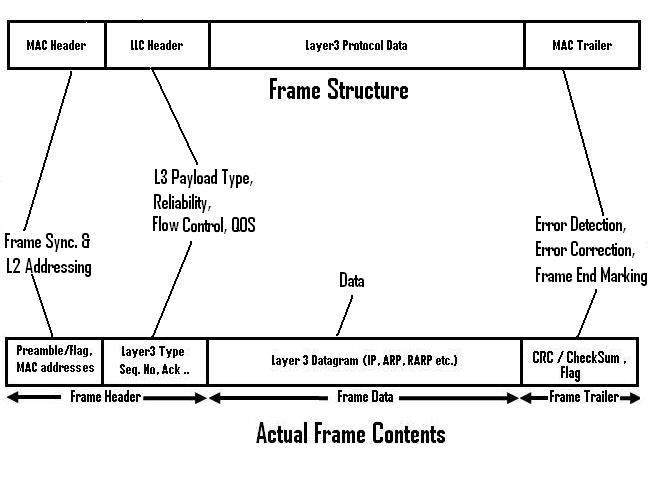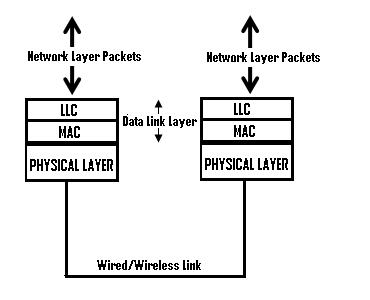This post briefly describes the general format of a data link layer frame.
The data link layer’s primary duty is to carry Network layer (L3) datagrams/packets inside frames to a next hop neighbor through a physical wired/wireless link. To achieve this, it usually takes each L3 packet and creates a frame by encapsulating the L3 packet with a Frame header and a Frame trailer. The L3 packet is sandwiched between the Frame header and trailer.
The Frame header usually consists of frame synchronization fields like Preamble/flags, control information necessary to carry the frames to the correct next hop neighbor like L2 addresses of source and destination node, L3 Protocol Type and optional fields for flow control and reliability. The Frame trailer usually consists of a CRC/checksum of the frame contents, for error detection purposes (and in some cases error correction too) and optionally an End-of-Frame Flag.
The generic data link layer frame structure is given in the diagram below

The generic frame structure consists of a MAC header, followed by a LLC header, then the actual L3 datagram to be carried to the next hop and then a MAC Trailer, as shown in the top portion of the above diagram.
The typical contents of each of these sub-blocks are shown in the bottom portion of the diagram. The MAC header and LLC header are usually combined and termed as the Frame header. A majority of Wired/Wireless LAN and WAN data link protocols follow the structure/format given above, though there may be a few exceptions.
Each of the sub-blocks of a typical data link layer frame is explained briefly below:
MAC header Fields
Preamble/SFD-Flag – Each frame usually starts with a known synchronization pattern. This pattern may be a combination of a preamble pattern, followed by a flag byte or just a flag byte alone.
In transmission, though the sender and receiver know the transmission rate apriori, the actual transmission rate at any instant, may not be constant always and may dynamically hover around this rate, due to drifts in the sender’s clock. The preamble is a standard sequence of multi-byte pattern, sent at the start of every frame and is used to constantly synchronize the receiver’s clock with that of the sender, so as to make the receiver’s measured bit interval duration to be the same as that of the sender’s current bit interval duration. In the preamble pattern, there must be enough clock transitions in known positions, so as to enable the receiver to latch onto the sender’s current clock frequency. For e.g. Ethernet uses a 7 byte pattern consisting of alternating 1’s and 0s as the preamble pattern.
The SFD (Start Frame Delimiter) Flag is another standard byte pattern agreed between the sender and receiver. The purpose of the SFD Flag is to enable the receiver to know the position of the actual frame header. On seeing the SFD flag byte, the receiver would know that the actual frame contents start immediately after the SFD flag. For e.g. Ethernet uses the SFD byte with value 10101011. Note that the last 2 bits have consecutive 1 bits. So, when a receiver receives the preamble pattern, followed by this SFD byte, it can start processing the actual frame contents starting from the byte immediately succeeding the SFD byte.
In many protocols, an explicit preamble pattern is not used and in such cases, the SFD flag is used for both clock synchronization and for frame beginning identification. For e.g. PPP does not use a preamble and only uses a SFD, with a byte value of 01111110.
Note : One may wonder as to what would happen if the L3 data itself contains the preamble/SFD-Flag patterns. To overcome the problem of the receiver mis-interpreting this as start or end of a frame, standard “bit stuffing” or “byte stuffing” techniques are used. These bit/byte stuffing techniques examine the data pattern and insert extra bits/bytes to the L3 data, whenever the L3 data has the standard preamble/SFD-Flag pattern inside it. These extra bits/bytes are then filtered out by the receiver to get the original L3 data. This way, the sender makes sure that the Preamble/SFD-Flags are unique within a data link layer frame.
Layer 2 Addresses : The MAC header also contains L2 addresses (termed as MAC addresses) of the destination and source computers, so that the frame reaches the correct destination. In some Wireless LAN protocols, the L2 addresses of base stations too are carried in the MAC header.
LLC Header Fields
Network Layer (L3) protocol type : The main field of the LLC header is the unique identifier of the Layer3 protocol whose data is being carried by this frame. This value is used by the receiver to hand over the frame to the correct L3 protocol or NSAP (Network Service Access Point). In many cases, an L2 frame may carry another L2 frame (of a different protocol) inside it. This is usually referred to as tunnelling. For e.g. An Ethernet frame may carry a PPP frame or an ATM cell. In such cases too, the protocol type field would be used to carry the identifier of the inner L2 protocol frame that is being carried. This field is also used for carrying VLAN (Virtual LAN) frames, with the value in this case being equal to the VLAN tagging protocol that is being used (e.g. 802.1Q or ISL). Example values for the protocol type fields are IP, ARP, RARP, PPP, ATM, 802.1Q etc.
Optional Fields: Apart from the L3 protocol type, all other fields in the LLC header are optional and are used only when the corresponding LLC service mode is used. Some of the important optional fields include
- Frame Types like Supervisory Frames(for Logical Connection establishment/teardown, flow control), Information Frames (for Data) and Unnumbered Acknowledgment Frames (for acknowledging Supervisory Frames)
- Sequence and Acknowledgment Numbers for Reliability
- COS (Class of Service) for indicating priority of this frame for QOS (quality of service) purposes
Note: In the internet, since reliability is taken care at the transport layer by the TCP protocol, most of the data link layer protocols do not use the optional LLC fields. They only use the L3 protocol type field of LLC. Due to this, the MAC hardware sub-block itself may add the complete Frame header, including the L3 protocol type field.
Frame Data (L3 Payload)
The actual L3 datagram/packet (e.g. IP, ARP, RARP etc.) is placed after the LLC header and before the Frame Trailer. Each frame contains exactly one L3 datagram. The maximum size of the Frame data varies based on the data link and physical layer protocols and is known as the Maximum Transmission Unit (MTU). For e.g. the MTU of standard Ethernet 10/100 Mbps links is 1500 bytes. If an L3 datagram’s length is greater than the MTU of the data link layer link through which it has to be carried, then the L3 datagram has to be fragmented into multiple smaller L3 datagrams and then sent in multiple L2 frames.
Similarly, some data link layer protocols have a minimum value for MTU, due to physical layer constraints. For e.g. the data portion of an Ethernet frame has to be atleast 46 bytes. Dummy padding is used in cases where the L3 datagram’s size is less than this minimum value.
Frame Trailer Fields
The frame trailer usually consists of a CRC/checksum value of the whole frame, for error detection purposes. CRC/Checksums are basically mathematical functions applied on the frame contents, to detect bit corruption due to different noise sources on the link. While the sender adds a checksum to every frame, the receiver verifies the checksum independently, before accepting a frame as valid. For erroneous links like wireless links, the CRC/checksum may have more redundant bits, so as to enable the receiver to not only detect bit errors, but also to correct upto a certain number of bit errors. Error correction is not used generally in wired links, as they are more reliable than wireless links.
The frame trailer may also optionally have an End-Of-Frame Detector Flag (EFD-Flag), for the receiver to know the end of a particular frame. This may be the same byte as the SFD-Flag. For e.g. PPP uses the standard value of 01111110 as the EFD-Flag.

